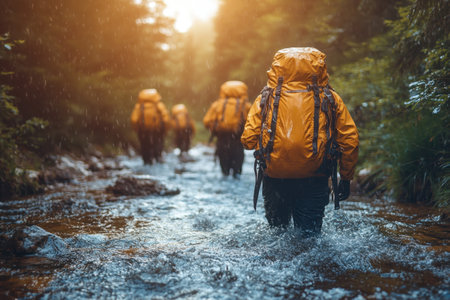1. Why Hydration Matters After a Hike
After a tough hike, it’s easy to focus on resting your legs or grabbing a snack, but one of the most important steps in recovery is rehydrating your body. Proper hydration isn’t just about quenching your thirst—it plays a major role in helping your muscles recover, keeping your joints moving smoothly, and making sure you feel good overall.
How Dehydration Affects Your Body Post-Hike
When you’re out on the trail, especially in hot or dry conditions, you lose water through sweat and breathing. Even mild dehydration can leave you feeling fatigued, crampy, or foggy-headed once the hike is over. Staying on top of your fluids helps your body bounce back faster and supports flexibility by making sure your joints are well-lubricated.
Main Benefits of Hydration After Hiking
| Benefit | How It Helps Recovery & Flexibility |
|---|---|
| Muscle Recovery | Water helps flush out waste products like lactic acid that build up during exercise, reducing soreness and speeding up healing. |
| Joint Lubrication | Proper hydration keeps the fluid in your joints at healthy levels, supporting smooth movement and reducing stiffness. |
| Overall Well-being | Staying hydrated helps maintain energy levels, clear thinking, and stable mood after physical activity. |
Quick Tips for Post-Hike Hydration
- Drink water steadily: Sip rather than chug—your body absorbs small amounts more efficiently.
- Add electrolytes if needed: If you sweated a lot or hiked for hours, sports drinks or electrolyte tablets can help replace lost minerals.
- Check your urine color: Pale yellow means you’re hydrated; dark yellow suggests you need more fluids.
- Pair with nutrition: Eating fruits like oranges or watermelon can boost both hydration and nutrient intake.
By making hydration a priority as soon as you finish hiking, you’ll help your body recover faster and stay flexible for future adventures.
2. Smart Nutrition Choices for Post-Hike Recovery
After a long hike, your body needs the right foods to repair muscles and restore energy. Choosing nutrient-dense foods is key to bouncing back faster and feeling flexible for your next adventure. Let’s break down what your body needs and where you can get it.
Why Nutrient-Dense Foods Matter
Nutrient-dense foods pack a lot of vitamins, minerals, and other nutrients without too many empty calories. After hiking, your muscles are tired, and your energy stores are low. Eating smart helps your body recover and keeps you feeling strong and limber.
What Should You Eat After a Hike?
Focus on three main types of nutrients: proteins, healthy fats, and complex carbs. Here’s how they help:
| Nutrient | Role in Recovery | Easy Examples |
|---|---|---|
| Protein | Repairs muscle fibers and supports growth | Grilled chicken, Greek yogurt, eggs, tofu, cottage cheese |
| Healthy Fats | Reduces inflammation and supports joint health | Avocado, nuts, olive oil, salmon, nut butter |
| Complex Carbs | Restores energy stores (glycogen) | Quinoa, brown rice, whole wheat bread, sweet potatoes, oatmeal |
A Simple Post-Hike Meal Idea
Create a balanced plate with lean protein (like grilled chicken or beans), a serving of complex carbs (such as brown rice or roasted sweet potatoes), and some healthy fats (add sliced avocado or drizzle olive oil). Toss in some leafy greens for extra vitamins!
Snack Smart: Quick Recovery Options
If you’re on-the-go or not ready for a full meal, choose snacks that combine these nutrients:
- A handful of trail mix with nuts and dried fruit
- A banana with peanut butter
- Cottage cheese with berries
- A turkey and cheese wrap in a whole wheat tortilla
- Greek yogurt topped with granola and seeds
Timing Matters Too!
For best results, aim to eat within 30 to 60 minutes after finishing your hike. This is when your body is primed to use those nutrients for recovery.

3. Electrolyte Replenishment and American Approaches
When you’re hiking in the U.S., especially on those long, challenging trails, your body sweats out not just water, but also important electrolytes like sodium, potassium, magnesium, and calcium. These minerals are essential for muscle function, nerve signals, and overall hydration. Failing to replace them after a hike can lead to cramps, fatigue, headaches, and slowed recovery—which means less flexibility for your next adventure.
Why Restoring Electrolytes Matters
Electrolytes help balance fluids in your body and keep your muscles working smoothly. After a demanding hike, if you only drink water without replenishing these minerals, you might end up diluting your remaining electrolytes further—a problem sometimes called “hyponatremia.” That’s why smart post-hike recovery in America always includes both fluids and electrolytes.
Popular Electrolyte Sources Among U.S. Hikers
American hikers have developed their own favorite ways to restore electrolytes quickly and conveniently. Some prefer store-bought solutions, while others go for simple snacks or DIY mixes. Here’s a quick comparison of popular options:
| Source | Form | Key Electrolytes | Common Brands/Examples | Notes |
|---|---|---|---|---|
| Sports Drinks | Liquid (bottled or powder) | Sodium, Potassium | Gatorade, Powerade, Liquid I.V. | Widely available; often high in sugar |
| Electrolyte Tablets/Powders | Dissolvable tablet/powder packets | Sodium, Potassium, Magnesium | Nuun, LMNT, GU Hydration Tabs | Portable; easy to mix with water; low-calorie options available |
| Trail Snacks | Solid (food) | Sodium (main), some potassium/magnesium depending on snack | Pretzels, salted nuts, jerky | No mixing needed; boosts energy as well as salt levels |
| Coconut Water | Beverage (bottled or box) | Potassium (main), some sodium/magnesium | Zico, Vita Coco | Natural source; less sodium than sports drinks but more potassium |
| DIY Mixes | Add ingredients to water bottle (salt + juice) | Sodium, Potassium (from juice) | Lemon/lime juice with a pinch of sea salt and honey | Budget-friendly; customizable flavor and sweetness |
Tips for Effective Electrolyte Recovery on American Trails:
- Pace Your Intake: Don’t chug all at once—spread out sips of electrolyte drinks or snacks over an hour post-hike.
- Read Labels: Not all products have the same mineral content; check for sodium and potassium especially.
- Balance With Food: Pair your electrolyte drink with a small meal or snack for better absorption and energy replenishment.
The Takeaway: Make Electrolyte Recovery a Habit!
If you want to bounce back faster and keep your joints feeling flexible for the next day’s adventure, don’t overlook electrolytes. Whether you pack Gatorade powder or grab a handful of pretzels at the trailhead parking lot, these little choices can make a big difference in how you recover after hitting America’s great outdoors.
4. Flexibility: Stretching, Refueling, and Recovery
The Connection Between Flexibility and Recovery
After a long hike, your muscles can feel tight and tired. Good flexibility helps your body recover faster and lowers the risk of soreness or injury. But staying flexible isnt just about stretching—what you eat and drink also plays a big role in how well your body bounces back.
How Nutrition Supports Post-Hike Flexibility
Your muscles need certain nutrients to repair and stay limber after physical activity. Eating foods rich in protein helps rebuild muscle fibers, while vitamins and minerals like magnesium and potassium support muscle relaxation and reduce cramps. Carbohydrates are important too—they refill your energy stores, so your muscles dont feel stiff for days.
| Key Nutrient | Main Benefit for Flexibility | Food Sources |
|---|---|---|
| Protein | Muscle repair & recovery | Chicken, eggs, Greek yogurt, tofu |
| Magnesium | Muscle relaxation & cramp prevention | Nuts, seeds, leafy greens, bananas |
| Potassium | Reduces muscle stiffness & soreness | Sweet potatoes, avocados, beans |
| Carbohydrates | Refuel muscles & maintain mobility | Whole grains, fruits, granola bars |
| Antioxidants (Vitamin C/E) | Reduces inflammation & supports healing | Berries, oranges, spinach, nuts |
The Importance of Hydration for Mobility
Water is essential for keeping your joints lubricated and your muscles elastic. Dehydration can make your muscles feel tighter and more prone to cramping. After hiking, aim to sip water steadily instead of gulping it all at once. You can also try drinks with electrolytes if you sweated a lot on the trail.
Simple Hydration Tips:
- Cary a reusable water bottle: Take small sips regularly during and after your hike.
- Add electrolytes if needed: Especially if hiking in hot weather or at high intensity.
- Avoid sugary sodas: They don’t hydrate as well as water or sports drinks.
The Benefits of Post-Hike Stretching Routines
Stretching after hiking helps relax tight muscles and increases blood flow to speed up recovery. Focus on gentle stretches for your calves, hamstrings, quads, hips, and lower back. This not only improves flexibility but also reduces muscle stiffness so you’re ready for your next adventure.
Sample Post-Hike Stretch Routine:
- Standing quad stretch: Hold each side for 30 seconds.
- Calf stretch against a wall: Hold for 30 seconds per leg.
- Seated hamstring stretch: Hold for 30 seconds per leg.
- Kneeling hip flexor stretch: Hold for 30 seconds per side.
- Lying spinal twist: Hold for 20-30 seconds each side.
Together, proper nutrition, hydration, and stretching help keep your body flexible and mobile after every hike—so you can hit the trails again sooner and feel great doing it!
5. Culturally Relevant Tips and Snacks for U.S. Hikers
Hydration Habits Popular on U.S. Trails
Staying hydrated is key for post-hike recovery, especially in the diverse climates found across the United States. American hikers often rely on lightweight, refillable water bottles and hydration reservoirs (like CamelBak packs) to keep fluids handy on the go. Some trails offer water stations, but many hikers bring portable water filters or purification tablets to safely use natural sources. Sipping regularly rather than waiting until thirsty is a common tip—this helps maintain energy and supports flexibility in tired muscles after a hike.
Classic American Trail Snacks for Recovery
Nutrition after a hike is about refueling and repairing your body. U.S. hikers favor snacks that are easy to pack, calorie-dense, and provide a mix of protein, healthy fats, and carbs. Below are some popular choices you’ll find in backpacks from coast to coast:
| Snack | Main Benefits | Cultural Notes |
|---|---|---|
| Trail Mix (“GORP”) | Protein, healthy fats, quick energy | A classic blend of nuts, dried fruit, and sometimes chocolate; “Good Old Raisins & Peanuts” is an old-school name for it. |
| Beef Jerky | High protein, salty for electrolyte replacement | A favorite among American hikers for its shelf stability and satisfying taste. |
| Granola Bars/Energy Bars | Convenient carbs and protein | Brands like Clif Bar or KIND are trail staples for Americans. |
| Peanut Butter Sandwiches | Sustained energy from protein and healthy fats | A nostalgic comfort food that travels well on hikes. |
| Dried Fruit (apricots, mango, apple rings) | Naturally sweet carbohydrates, vitamins | Packed for quick sugar boosts without refrigeration. |
| Electrolyte Drink Mixes (Nuun, Gatorade powder) | Replaces lost salts and minerals | Dropped into water bottles for easy hydration upgrades. |
Practical Hydration & Nutrition Tips for American Hikers
- Plan ahead: Research if your trail has reliable water sources or if you’ll need to carry all your water.
- Pace your intake: Drink small amounts often instead of chugging large volumes at once.
- Mimic local habits: In hot regions like the Southwest, add extra electrolyte powders; in cooler areas, pair snacks with warm drinks in insulated mugs.
- Pack what you love: Choose snacks you actually enjoy—recovery foods don’t have to be boring!
- Balance nutrients: Try to combine carbs (for energy), protein (for muscle repair), and healthy fats (for satiety) in each post-hike snack.
- Savor the social aspect: Sharing snacks at the trailhead or parking lot is a beloved part of U.S. hiking culture—bring extra to trade or share with new friends!


